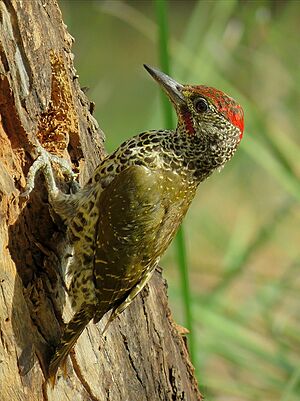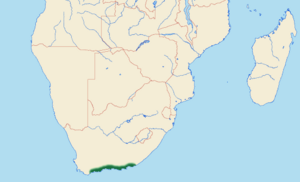Knysna woodpecker facts for kids
Quick facts for kids Knysna woodpecker |
|
|---|---|
 |
|
| Campethera notata, Addo Elephant National Park, South Africa | |
| Conservation status | |
| Scientific classification | |
 |
|
| resident range |
The Knysna woodpecker (Campethera notata) is a special type of bird that lives only in South Africa. It's known for its unique spotted look. This woodpecker makes its home in warm, wet places like forests, savannas (grassy plains), and shrublands (areas with lots of bushes). Sadly, its home is shrinking, which puts the bird at risk. The Knysna woodpecker is part of a group of similar woodpeckers, including the golden-tailed and Mombasa woodpeckers.
Contents
About the Knysna Woodpecker
The Knysna woodpecker is a medium-sized bird, about 21.5 centimeters (8.5 inches) long. It stands out from other woodpeckers in South Africa because its whole underside, from its chin to its tail, is covered in thick black spots.
What Does It Look Like?
Both male and female Knysna woodpeckers are mostly olive-green on their backs. They have faint, small bars and some pale yellow, diamond-shaped spots.
- Male Knysna Woodpecker: The male has a gray-black head with scarlet (bright red) tips on its feathers. The back of its head (called the occiput) is completely bright scarlet. Its cheeks are also scarlet.
- Female Knysna Woodpecker: The female looks similar to the male. However, her black head has white spots, and only the back of her head (occiput) is scarlet.
The flight feathers (long feathers on the wings) are brown, but olive-green near the base. The secondary feathers (smaller wing feathers) are olive-brown with yellow-white bars. The primary feathers (main wing feathers) have yellow spots and white notches on the inner side. The tail is olive-brown with six yellow bars. The tips of the tail feathers are a dull golden color.
The area around its eyes is yellowish with tiny black spots. The feathers covering its ears are whitish with black streaks. The rest of its face and neck are yellowish-white with many black spots.
The underside of its body is yellowish, but white on its throat. As mentioned, it's covered in thick black spots. These spots are round and large on its chest, but more diamond-shaped on its belly. Its sides have dusky black bars. The feathers under its wings are yellow with round black spots, just like on its chest. The eyes of the Knysna woodpecker are hazel colored.
What Does It Eat?
The Knysna woodpecker mainly eats ants and their young (called larvae). It also enjoys wood-boring beetles and termites, including their eggs and young (called pupae).
This woodpecker searches for food at all levels of the tree canopy (the top layer of branches and leaves). It pecks into wood, picks insects off surfaces (called gleaning), and probes into cracks to find its prey as it moves along branches.
How Does It Reproduce?
Knysna woodpeckers usually breed between August and November, with October being the busiest month. Pairs build their nests far apart from each other.
They dig a nest hole in a dead tree trunk or branch. A female typically lays 2 to 4 eggs. She then sits on the eggs to keep them warm (this is called incubation) for 13 to 21 days. After the chicks hatch, they stay in the nest for another 4 to 6 days before they are ready to fly (this is called fledging).
Where Does It Live?
The Knysna woodpecker lives only in South Africa. It is spread out thinly along the coastal lowlands. Its range extends north into southern KwaZulu-Natal and west towards Bredasdorp, Western Cape. While it's common in some local areas, it's not common across its entire coastal home.
The total area where it lives is less than 50,000 square kilometers (about 19,300 square miles). Experts believe there are between 1,500 and 5,000 individual Knysna woodpeckers in total. Out of these, about 1,000 to 3,300 are adult birds that can reproduce.
Why Is It Near Threatened?
The IUCN Red List is a list that shows the conservation status of different species. As of 2012, the Knysna woodpecker is listed as "Near Threatened." This means it's not yet endangered, but it could become so in the near future.
Scientists predict that changes to its habitat (the natural place where it lives) will happen. These changes could affect more than 90% of the woodpecker population and cause a fast decline in their numbers. For example, in the 1800s, many coastal bushes in KwaZulu-Natal were cleared to grow sugar-cane and build towns. This caused the woodpecker's living area to shrink.
Protecting This Woodpecker
To help the Knysna woodpecker, several conservation efforts are underway or planned. One important step is to learn more about this species. For instance, about 1,000 to 1,500 Knysna woodpeckers are thought to live in protected areas like the Oribi Gorge Nature Reserve.
Some proposed actions to protect them include:
- Doing surveys to find out the exact total population size.
- Regularly checking population trends to see if numbers are going up or down.
- Researching what might be limiting the species' population growth.
- Increasing the amount of suitable habitat that is protected.


